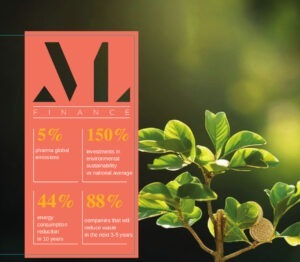The pharma sector accounts for almost 5% of global emissions. Given its power and resilience and, above all, given the uninspiring context, action in terms of reducing emissions and using resources more efficiently is more than possible: it is necessary. Politicians say so, society is clamouring for it, and legislation, which at the European level has addressed the environmental impact of treatment in several places, establishes it.
Despite understandable resistance related to the inflationary cycle and the aftermath of a pandemic that has had the well-known dramatic repercussions on the economy, the cost of sustainability must be considered an investment and initiatives in this area should be designed with this in mind.
A daunting challenge in a historical era accustomed to believing only in feedback that can be obtained entirely and immediately. But so it is: for various reasons, all before our eyes, interventions in sustainability (appropriately declined and planned) constitute the driver of development.
Seen from a more global perspective, the issue does not only concern individual companies, but also states, and not only in terms of obtaining solutions that improve the health of citizens, but also in terms of economic growth. What country can afford to spend large sums on technological and infrastructural innovation, or can call itself competitive if it is burdened by unsustainable health and social spending, linked to the resulting climate and environmental devastation and social inequalities?
Pharma, best sector for sustainability actions
Change has already been underway for some time. The last few years have seen a gradual but significant reduction in emissions and a communication focus on green issues.
During the celebration of World Environment Day on 5 June, Farmindustria president Marcello Cattani recalled how (according to Istat data) the pharmaceutical industry is the first sector for sustainability actions. Investment in environmental protection per employee is 150% of the national average, and over 200% for interventions in pollution prevention technologies, which zero or reduce environmental contamination at the source of the production process. 88% of pharmaceutical companies plan to significantly reduce the waste they produce in the next 3-5 years, while 55% are already committed to eliminating the use of plastics at every stage of the process.
On the occasion of COP28, which took place last December in Dubai, the pharmaceutical industry presented a joint communiqué shared by the major industry associations (the UK’s Abpi, Efpia, Farmindustria, Fpma, Canada’s Imc, Japan’s Jpma, France’s Leem, the US’s PhRMA and Germany’s Vfa).
The document commits companies in the sector to invest in research and development to provide more sustainable products, services and supply chains with the goal of zero net emissions and carbon neutrality.
Over the last 10 years, companies in Italy have reduced energy consumption by 44%, but if air emissions are taken into account, the reduction is as high as 51%.
Marcello Cattani – President Farmindustria
The margins for improvement
The road is marked out, but in some points the path needs to be corrected. In particular, the aspects that still need to be worked on are those of communication and the definition of measurable and reproducible indicators to define sustainability objectives. Two aspects that are more intertwined than they appear.
In many cases, the lack of objective criteria makes it impossible to assess the value of the actions undertaken: the result is a vulnus for corporate communication on ESG issues, which could be accused of greenwashing and suffer damage in terms of image, potentially penalising further praiseworthy initiatives. It should be noted, in this regard, that the omission of information in corporate communication can also be seen as an unfair practice: it is, for example, to state that a certain process is ‘zero-emission’ without specifying whether this result has been achieved primarily through offsetting actions.
Novo Nordisk, ‘Circular for zero’
The Danish company has embraced a process of evolution that puts it at the forefront of climate change, thanks to a more common and widespread grassroots awareness in northern European countries, but also to the realisation that it has to take a leading role as a manufacturer of pharmaceuticals associated with medical devices, which represent a specific criticality in terms of disposal.
Novo Nordisk has designed the ‘Circular for zero’ environmental impact strategy, aimed at identifying new ways to design products that can be recycled or reused, reshaping the business to minimise consumption and waste, and working with like-minded suppliers. In 2020, the company achieved its target of using 100% renewable electricity and by 2030 aims to generate zero CO₂ emissions from production and logistics activities.
Boehringer Ingelheim: curbing water consumption
Already by 2020, all the energy needed to operate Boehringer Ingelheim’s Italian sites will come from renewable sources. Currently, the company is implementing the principles of the circular economy to reduce waste from production activities that would have to be disposed of in landfills. In the same years that production volumes have been tripled, water consumption in the plants has been reduced by up to 65%. An initiative that goes back a long way, to times when the problem of droughts and imbalances in the availability of water resources were not yet a topic of public debate.
The company aims to achieve carbon neutrality across the group, globally, as early as 2030. The new headquarters inaugurated in Milan in 2022 is certified Leed Platinum (the highest level in the assessment of sustainable buildings) and has saved 100 per cent gas, 95 per cent water and 65 per cent electricity by 2022. The interventions did not only consider the production departments, but also involved the administrative offices. The objective, as reiterated by a series of press speeches by key management figures, is above all a radical change in people’s mentality and in the way they think about the production of medicines, which they imagine to be oriented towards the creation of value for the company and for the region in which it is located.
AstraZeneca: eliminating fluorinated gases
AstraZeneca’s extensive and detailed CO₂ (Ambition zero carbon) reduction plan, estimated to cost around $1 billion, has been put in place to achieve zero emissions by 2045. This programme includes a $400m investment (AZ Forest Programme) aimed at eliminating fluorinated gases from inhaler propellants and will contribute to an interim target of a 95% reduction in emissions by 2026 (compared to the 2015 baseline). AstraZeneca is pursuing the goal of halving its entire supply chain footprint by 2030, with a long-term target of a 90% reduction by 2045 (again from 2015 baseline).


